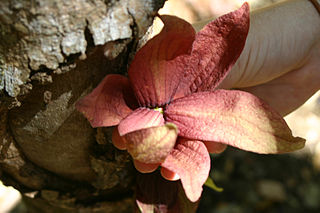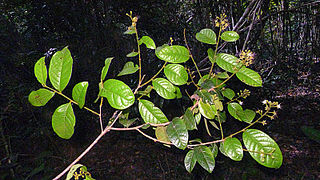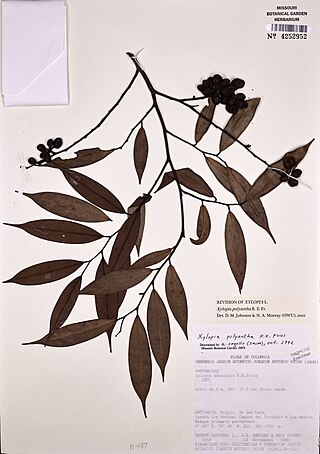
The Annonaceae are a family of flowering plants consisting of trees, shrubs, or rarely lianas commonly known as the custard apple family or soursop family. With 108 accepted genera and about 2400 known species, it is the largest family in the Magnoliales. Several genera produce edible fruit, most notably Annona, Anonidium, Asimina, Rollinia, and Uvaria. Its type genus is Annona. The family is concentrated in the tropics, with few species found in temperate regions. About 900 species are Neotropical, 450 are Afrotropical, and the remaining are Indomalayan.
Micrandra is a plant genus of the family Euphorbiaceae first described in 1854. It is native to South America.

Pouteria is a genus of flowering trees in the gutta-percha family, Sapotaceae. The genus is widespread throughout the tropical Americas, with outlier species in Cameroon and Malesia. It includes the canistel, the mamey sapote, and the lucuma. Commonly, this genus is known as pouteria trees, or in some cases, eggfruits.

Sapranthus is a genus of flowering woody plants in the family Annonaceae. The genus was first described in 1866 by Berthold Carl Seemann.

Rollinia is a genus of plants in the family Annonaceae. While it is widely recognised as a distinct genus a monograph published in 2006 advocates its inclusion in Annona, which also contains custard apples and soursops.

Hirtella is a genus of 110 species of woody trees in family Chrysobalanaceae. It was first described as a genus by Linnaeus in 1753. Hirtella naturally occurs in tropical forests throughout Latin America, the West Indies, southeast Africa, and Madagascar. The flowers are mainly pollinated by butterflies.
Pseudoxandra williamsii is a species of plant in the Annonaceae family. It is endemic to Peru. Robert Elias Fries, the Swedish botanist who first formally described the species using the basionym Cremastosperma williamsii, named it after Llewelyn W. Williams, the Welsh economic botanist, who collected the holotype specimen he examined.

Duguetia is a genus of trees and shrubs in the plant family Annonaceae with approximately 90 species in central and South America, and four species in west Africa.

Cremastosperma is a genus of flowering plants in the family Annonaceae, subfamily Malmeoideae, tribe Malmeae. In 2018 there were 34 recognised species distributed in Central and South America.
Annona cordifolia is a species of plant in the Annonaceae family. It is native to Bolivia, Brazil, Columbia and Peru.
Diclinanona is a genus of plants in the family Annonaceae.
Diclinanona calycina is a species of plant in the family Annonaceae. It is native to Brazil, Colombia, Peru and Venezuela. Ludwig Diels, the German botanist who first formally described the species using the basionym Xylopia calycina, named it after its well-developed calyx.

Pseudoxandra leiophylla is a species of plant in the family Annonaceae. It is native to Brazil, Colombia, and Venezuela. Ludwig Diels, the German botanist who first formally described the species using the basionym Unonopsis leiophylla, named it after its smooth leaves.

Pseudoxandra lucida is a species of plant in the family Annonaceae. It is native to Bolivia, Brazil, Colombia, Peru, and Venezuela. Robert Elias Fries, the Swedish botanist who first formally described the species, named it after its shiny leaves.

Pseudoxandra polyphleba is a species of plant in the family Annonaceae. It is native to Bolivia, Brazil, Colombia, French Guiana, Guyana, and Peru. Ludwig Diels, the German botanist who first formally described the species using the basionym Unonopsis polyphleba, named it after the distinctive veins in its leaves.

The Malmeoideae are a subfamily of trees and other plants of the family Annonaceae.
Desmopsis is a genus of flowering plants belonging to the family Annonaceae.
Pseudephedranthus is a genus of flowering plants belonging to the family Annonaceae.
Ruizodendron is a monotypic genus of flowering plants belonging to the family Annonaceae. It is part of Malmeoideae subfamily and Malmeeae tribe. The only known species is Ruizodendron ovale.

Xylopia polyantha is a species of plant in the Annonaceae family. It is native to Bolivia, Brazil, Colombia, Ecuador, and Peru. Robert Elias Fries, the botanist who first formally described the species, named it after its many flowers.











